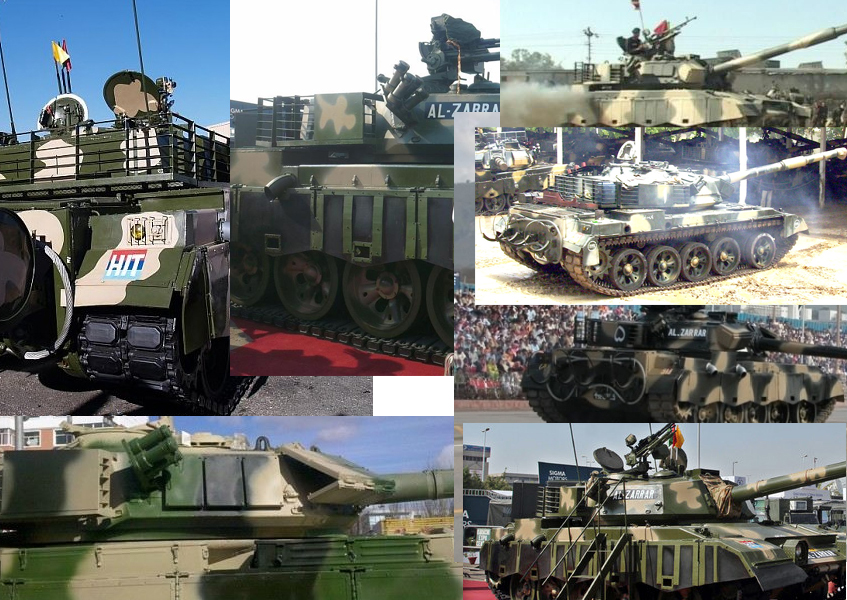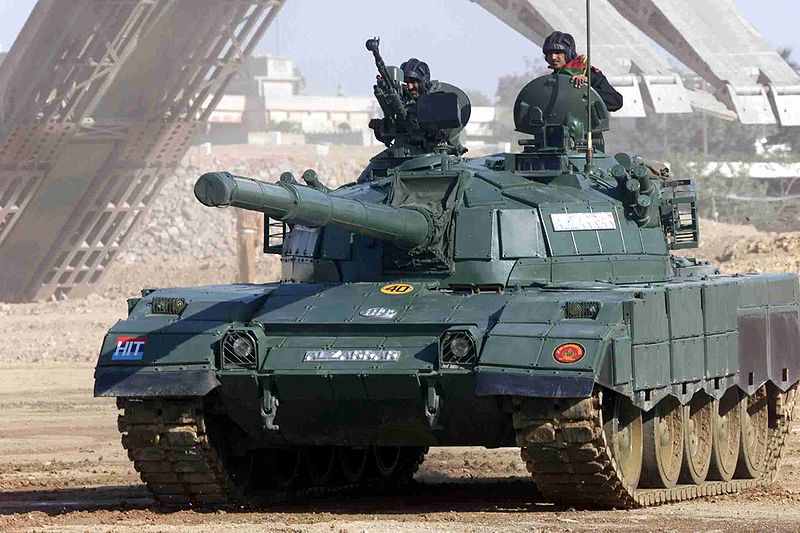Based on the Chinese Type 59 MBT
Pakistan already purchased the Type 59, a Chinese modified T-54, in the 1960s to 1990. This were the 100 mm and 105 mm version that Pakistan purchased in several batches: 80 were indeed ordered in 1964 and delivered between 1965 and 1966, followed by 210 between 1970 and 1972, 159 in 1974, 852 from 1978 to 1988. Around 1,300 Type 59s were in service in 1990, but by 2005 this figure fell at 600 while 300, then 400 Al-Zarrar replaced them as of 2010. Already in the 1980s, the Pakistani Army thought there was room for improvement, some as been the results of the Indo-Pakistani War of 1971 which showed some lack of firepower. Instead of devising a brand new battle tank, it was chosen to upgrade the ageing Type 59 fleet instead.Design
The upgrade program consisted of 54 modifications, aimed at firepower, mobility and protection by the Heavy Industries Taxila (HIT) in 1990. The first upgrade program was achieved in 1997, the a second took place with more extensive modernization partly based on the Al Khalid program. Three prototypes were indeed built to tests various features, notably FCS. After an extensive tests campaign, the final version of the Al Zarrar was transformed in a serie modernization by project manager Mahmood Khan. The first batch of 80 tanks (second model) was delivered to the army in February 2004.Mobility
The original engine was a 520hp diesel. The new powerplant is a liquid-cooled 12-cylinder diesel engine, producing a 730 hp output or 540 kW, and a torque output of 305 kg.m at 1300–1400 rate per minute. The overall combat weight of the Al-Zarrar was 40 tons, which translated into a power-to-weight ratio of 18.3 hp/tonne. Top speed is 65 km/h. To improve the ride quality, modified torsion bar suspension systems were fitted as well as two return rollers per side, so to reduce the vibrations and possibly preventing excessive wearing of the roadwheel rubber band by the track pins.Firepower
The most notable asset of the Al Zarrar was its smoothbore 125 mm with an autofrettaged, chrome-plated gun barrel. Ammunitions comprised APFSDS, HEAT-FS and HE-FS rounds, ATGMs, as well as the Pakistani DU (depleted uranium) round Naiza. The latter was tested and showed its ability to penetrate 550 mm of RHA armour at 2000 m. In addition there is semi-automatic autoloader. The main gun dual-axis stabilized and uses thermal imaging sights for the commander and gunner. There is also a completely modernized fire-control system with computerized image stabilisation, including a laser range-finder coupled with a ballistic computer to improve accuracy, GPS navigation system, and data provided by sensors. An improved gun control helps to take the best of this combination. As a secondary armament, the Al Zarrar uses a 12.7 mm heavy anti-aircraft machine gun mounted on the roof, around the loader\'s hatch, also fitted with a remote aiming device to be fired from inside the tank. There is also a coaxial 7.62 mm machine gun.Protection
Outside the regular RHA of the basic hull, there is a modular add-on composite armour (on the second type), anti-mine armour and explosive reactive armour (ERA) blocks on the turret and front side skirts to give some improved protection against ATMs and RPGs. There is a locally-built ATCOP LTS-1 laser threat warning system to make the crew aware the tank is by a laser range-finder/designator beam. to improve survivability against visual aiming devices, Smoke grenade launchers are fitted on the turret sides. In addition to a similar system inside the engine compartment, there is an automatic fire-extinguishing and explosion suppression system inside the crew compartment.Exports
Form now on, HIT's Al Zarrar has never been exported, but the range of upgrades are now propose as a "kit" for the Type 59 and even more numerous T-54/55s in service. By October 2008, the chief of the Bangladesh Army met his Pakistani counterpart and a program was initiated to modernize the Type 59 Bangladeshi fleet along the same lines as the Al Zarrar. A joint venture was established, with technology transfers and around 300 Type 59 and 59-II are intended to be overhauled and upgraded at the Bangladesh Army\'s 902 Heavy Workshop.Al-Zarrar specifications |
|
| Dimensions : | 6,04 (hull) x 3,27 x 2,59 m (19.8 x 10.7 x 8.6 ft) |
| Total weight, battle ready | 40 tons (8,000 lbs) |
| Crew | 4 (commander, driver, gunner, loader). |
| Propulsion | HIT V12 Diesel 730 bhp (540 KW), 305 kg.m @ 1300–1400 rpm |
| Speed | 65/40 km/h road/cross-country (40/24 mph) |
| Range/consumption | 500 km (310.6 mi) |
| Armament | One 125 mm smoothbore (5.5 in) gun One coaxial 7.62 mm(0.3 in) machine-gun One roof-mounted AA 12.7 mm (0.5 in) remote firing HMG |
| Armor | Classified. RHA & composites, ERA. See notes |
| Ammunition used | HESH, AP, frag, HE, APDS, APFSDS, ATGM, DU |
| Total converted | 600 |
Links
The Al-Zarrar on WikipediaThe Al-Zarrar on army-technology
Gallery

Composition of references found on the web. For painting and details references only. Camouflage patterns includes dark green with cyan (Early type, first photo below, olive green with sand beige spots, or olive green/dark green with sand beige spots)


Pakistani Type 59-I in Peshawar in 2011, for comparison. Around 600 re still in service with the Pakistani Army today.

Pakistani Al-Zarrar type 1 (1998) protected by ERA.

The type 2 from 2004 with reinforced side skirts.

The side skirts are omitted to show the two return rollers positions.

As shown by the photo references in full armour protection by 2010-2015, with appliqué, composite, reinforced side skirts and turret/sides ERA.

Modern Tanks
Modern MBTs posters

Denel Bagder (2018)

Type 16 MCV (2016)

Gepard 1A2 last rounds 2011

SANDF

Russian AFVs

Main Battle Tanks
